The island of Patmos has an area of 34 sq. kilometres and a
coastline of 63 kilometres making it one of the
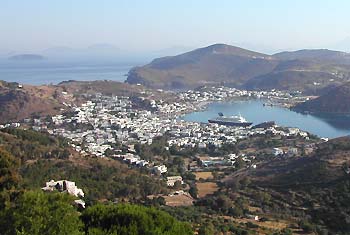 smallest inhabited
islands in the Aegean. With an approximate population of 3000
persons, Patmos forms part of the Dodecanese Islands and lies
between the islands of Leros, Fourni and Ikaria.
smallest inhabited
islands in the Aegean. With an approximate population of 3000
persons, Patmos forms part of the Dodecanese Islands and lies
between the islands of Leros, Fourni and Ikaria.
Famous for its religious past, the island is where Saint John wrote the Book of Revelation. Also known as the "Jerusalem of the Aegean", Patmos was formally declared a Holy Island in 1983 by the Greek government. For many years now, Patmos has been an island of pilgrimage for Catholic and Orthodox faithful who come to the island to absorb the spiritual heritage and bask in its beauty and serenity. Today, this mountainous island with small coves also attracts various sun lovers, wanting to swim in the crystalline waters.
The 2 most architecturally significant elements of Patmos are the towns of Skala and Chora, which is dominated by the majestic and fortress like, Byzantine monastery of Saint John. Although the architecture is traditionally Dodecanese, there are similarities with the Cycladic style of cubic whitewashed houses with flat or tiled roofs and an assortment of coloured shutters and doors.
THE TOWNS AND VILLAGES OF PATMOS
Skala
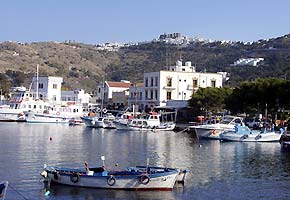 The main harbour of Patmos, Skala is the most populated town on the island.
The main harbour of Patmos, Skala is the most populated town on the island.
Skala as is stands today started its development in the 19th century as prior to this it was susceptible to pirate raids. Houses started to be built and the area gradually became a business and shipping centre. Now with the growth of tourism, Skala is taking on the role of "the city of Patmos" offering the most in the way of public services, supermarkets, gift shops, restaurants, and evening entertainment.
All roads lead to Skala on this island so chances are you will be passing through Skala several times a day. Regular buses connect Skala with the rest of Patmos and there are fishing boats offering daily excursions to various secluded beaches.
Among the many sights of Skala are the ruins of the ancient acropolis, the convent of Zoodochos Pigi, and the church of Panagia Koumana.
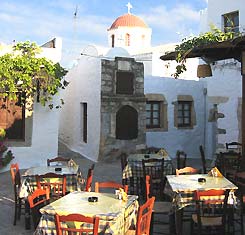 Patmos Town (Chora)
Patmos Town (Chora)
Chora is the capital of Patmos and can be found 4km to the southwest
of Skala. Built around the imposing fortified Monastery of Saint
John during the 12 century, the town came to prominence during the
16 Century when beautiful mansions houses and captain residences
were built, testifying to the wealth of the people of Patmos. These
can be seen along side the traditional architecture of lovely
whitewashed houses on narrow streets and alleyways with flourishing
courtyards.
There is a donkey track going from Skala to Chora that was built in 1794. It starts about 1 kilometre in from the port, and takes between 20-30 minutes to walk up to Chora, which can be hard work on a hot summers day. A good idea would be to take a bus up to Chora and walk down, calling in to visit the Cave of the Revelation before returning to Skala.
Kambos
A picturesque village approximately 11 kilometres from Chora. In
actuality it's two villages Pano & Kato Kambos (upper & Lower Kambos).
The principal is Pano Kambos, with it's village square, school, the
beautiful church of the Annunciation plus small tavernas with a good
traditional food. Kato Kambos is enchanting, full of greenery,
whitewashed houses and narrow alleys plus has one of the best
beaches on Patmos.
Grikos
Situated approximately 5 kilometres from the port of Skala, with a
road that runs parallel to the coast making walking to and from
Skala very beautiful. Grikos is a lovely fishing village and a
popular village during the summer because it is quieter than most
towns around the island.
THE BEACHES OF PATMOS
Patmos may not be a large island but the coastline offers a varied selection of beaches from well organised sandy beaches with beach bars to solitary coves for those moments of tranquillity. Due to the strong religious association, Patmos has never being an island very tolerant with nudism and there are many sings prohibiting topless and nude bathing. But times are changing and with the growth of tourism, signs are often ignored in the more isolated areas.
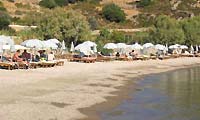 Kambos
Kambos
Kato Kambos or Kambos beach is the most popular beach on the island.
It is mainly a sandy beach with small pebbles, extending over
kilometres, with clean, shallow waters making it safe for children
and plenty of tamarisk trees for natural shade. Kambos beach is the
best organised beach of Patmos with sun beds, umbrellas and various
water sports facilities.
Agriolivado
A sand and pebble beach surrounded by lush vegetation approximately
2 kilometres north of Skala. There is a taverna and beach bar and on
the beach you can find sun beds and umbrellas. Its mainly shallow
waters make it ideal for children with the added attraction of some
water sports being available.
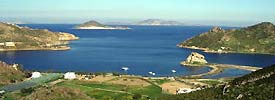 Grikos
Grikos
The longest beach on Patmos, sandy with with crystal-clear waters,
umbrellas, sun beds and a lot of water sports. A good place for
families. It is also close to Alikes Beach and 5 kilometres
south-east of Chora, the capital of Patmos.
Skala
This is the beach located just next to the port of Patmos. Skala is
a sandy beach with shallow and clean waters but which can get very
crowded during high season.
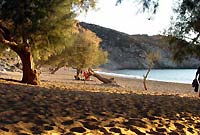 Psili Ammos
Psili Ammos
Located on the south-west corner of Patmos and about 10 kilometres
south of Chora. Not the most accessible beach but well worth the
effort. A picturesque cove with pure golden sand, sweeping dunes and
lined with many tamarisk trees.
Unofficially divided in half, the furthest end is the nudist half even if nudism is prohibited on Patmos on some beaches it is tolerated. There is also a taverna which serves excellent local food. You can get to Psili Amos by regular water taxi from Skala (takes about 45 minutes) or by bus until Diakofti followed by a 30 minute walk!
Meloi
This beach is only only two kilometres north-east of Skala. A golden
sandy beach with clear waters and tamarisk trees for shade. The
islands camp site is only 20 meters away from the beach and has a
popular restaurant and a mini market.
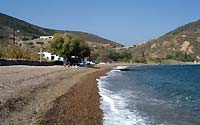 Lambi
Lambi
A pebble beach to the north of Patmos. The word Lambi is derived
from the sun reflecting against the multicoloured pebbles and the
clear waters of the bay.
Lambi can be reached from Kambos beach, walking it takes around 25 minutes or by fishing boat from Skala if the winds are not too strong. A pleasant location for lunch or dinner with tavernas on the beach serving delicious food in a peaceful atmosphere.
WORTH SEEING ON PATMOS
Monastery of St. John
Or in Greek, the monastery of Agios Ioannis Theologos, is the first
thing you will notice when arriving on
 Patmos, sitting high on the
hill above Chora it is visible from every part of the island.
Established in 1088, it has remained the most significant religious
and cultural centre on the island.
Patmos, sitting high on the
hill above Chora it is visible from every part of the island.
Established in 1088, it has remained the most significant religious
and cultural centre on the island.
As you enter the gate you come to the main courtyard inlaid with local pebbles and stones. The eastern side is dominated by an arch with four curves and many frescoes representing the miracles performed by Saint John. In total, the monastery houses ten chapels, and the most impressive part of the monastery is the main chapel with a beautiful wood-carved icon stand, marble floor and rich decoration.
The Library, established by St Christodoulos, is of extreme interest, it includes 2,000 volumes, 13,000 historic documents and 900 manuscripts.
There is also a museum, located next to the bakery. It houses an amazing collection of icons, original manuscripts, sacred relics, vestments embroiled with silver or gold threads and bejewelled with precious stones to list a few. Most of the items within the museum must be seen to be fully appreciated.
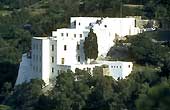 Cave of the Apocalypse
Cave of the Apocalypse
St. John the Divine is said to have made his home in this cave and
is said to be where he had his revelation, which he dictated to his
disciple, Prohoros, and became known as the Book of the Apocalypse,
or Revelation, the last book of the Christian Bible. The cave today
is enclosed within a sanctuary. There is a monk and/or spiritual
leader that will guide you through the cave, although it is
recommended to sit on one of the stools and absorb the energy of
this miraculous cave that some believe is one of the great mysteries
of the world.
Zoodohou Pigis
A women's convent in Chora that was founded by the abbot of the
monastery of St. John, in 1607. Even though under renovation the
convent is worth a visit. There are two churches, Zoodohou Pigis and
St. John the theologian, both with icons dating from the 16th to the
18th century. The courtyards are filled with bougainvilleas and
other flourishing flowers well taken care of by the nuns who also
make incense and sow or embroider religious garments.
For accommodation on Patmos,
please click here to send us an e-mail with your request.
